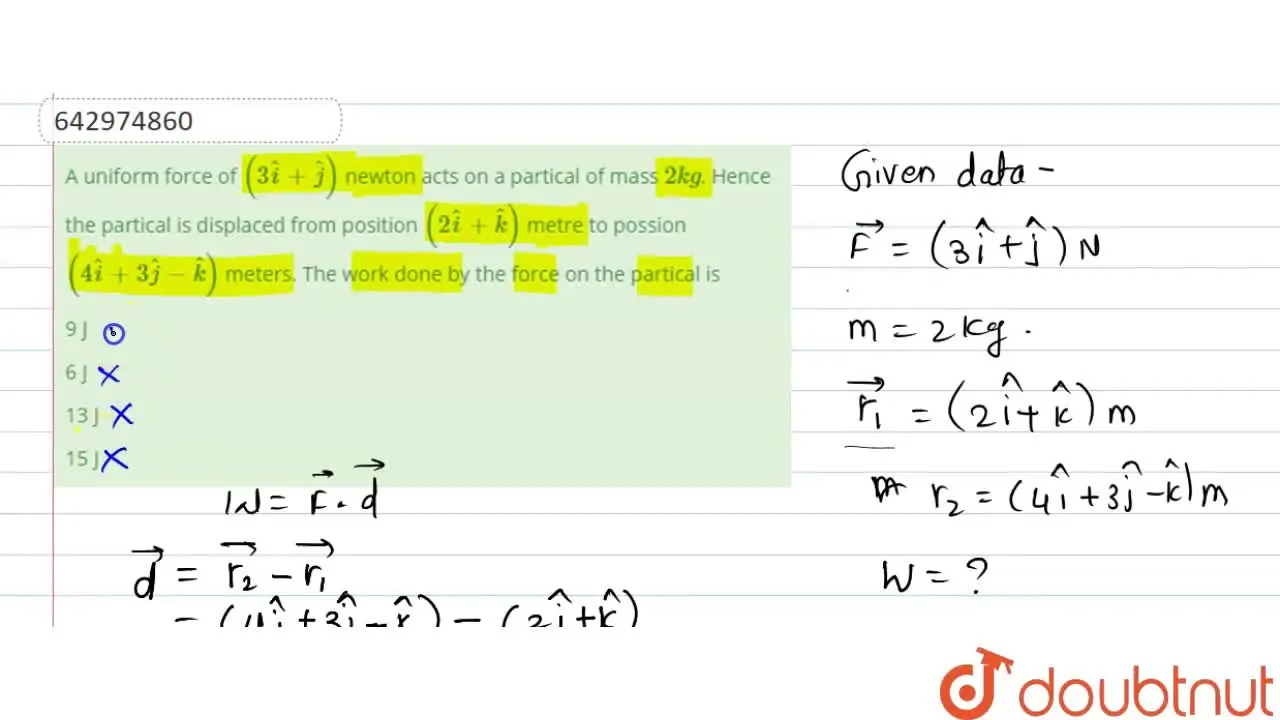A uniform force of newton acts on a partical of mass . Hence the partical is displaced from position metre to possion meters. The work done by the force on the partical isSolution in Marathi
9 J
6 J
13 J
15 J
The correct Answer is:A
Step by step video & image solution for A uniform force of (3 hati + hatj) newton acts on a partical of mass 2 kg. Hence the partical is displaced from position (2 hati + hatk) metre to possion (4 hati + 3 hatj - hatk) meters. The work done by the force on the partical is by Physics experts to help you in doubts & scoring excellent marks in Class 11 exams.
Related Playlists
- BOOK - TARGET PUBLICATIONCHAPTER - FORCE EXERCISE - Competitive Theinking (4.4 Elastic and inelastic collision)23videos
FORCE
- BOOK - TARGET PUBLICATIONCHAPTER - FORCE EXERCISE - Competitive Theinking (4.5 Inertial and non-inertial frames)2videos
FORCE
- BOOK - TARGET PUBLICATIONCHAPTER - FORCE EXERCISE - Competitive Theinking (4.2 General idea of gravitational, electromagnetic and nuclear force from daily life experiences)3videos
FORCE
- BOOK - TARGET PUBLICATIONCHAPTER - ELECTROSTATICSEXERCISE - EXCERCISE156videos
ELECTROSTATICS
- BOOK - TARGET PUBLICATIONCHAPTER - FRICTION IS SOLIDS AND LIQUIDS EXERCISE - MCQ (EVALUATION TEST)21videos
FRICTION IS SOLIDS AND LIQUIDS
Similar Questions
A bullet hits and gets embedded in a solid block resting on a frictionless surface. In this process, which of the following is correct ?
02:09View SolutionA reference frame attached to the earth
01:54View Solutionwhich of the following is correct order for forces?
01:06View SolutionElectrostatic means study of
01:29View SolutionA body while sliding went straight down an incline of 45∘ to the horizontal and was subjected to a coefficient of kinetic friction of 0.20. Starting from rest, hwo long did it take him to reach a speed of 50km/hr? (Ignore air resistance and take h=10m/s2)
00:54View SolutionA force F = (5 hati + hatj) newtons is is applied over a partical which displaced it from its origin to the point r = (2 hati - hatj) metres . The work done on the partical is.
02:36View SolutionA particle moved from position vec r_(1) = 3 hati + 2 hatj - 6 hatk to position vecr_(2) = 14 hati + 13 hatj +9 hatk undre the action of a force (4 hati + hatj +3 hatk) newtons . Find the work done .
03:01View SolutionA force (→F)=3ˆi+cˆj+2ˆk acting on a partical causes a displacement: (→s)=−4ˆi+2ˆj+3ˆk in its own direction . If the work done is 6j, then the value of c is
01:56View SolutionA uniform force of (3ˆi+ˆj) newton acts on a partical of mass 2kg. Hence the partical is displaced from position (2ˆi+ˆk) metre to possion (4ˆi+3ˆj−ˆk) meters. The work done by the force on the partical is
05:24View SolutionA force of (3ˆi+4ˆj) Newton acts on a body and it by (3ˆi+4ˆj)m. The work done by the force is
02:26View SolutionFind the torque of a force (5ˆi−2ˆj+3ˆk) about the origin, which acts on a particle whose position vector is (ˆi−ˆj+ˆk).
03:43View SolutionUnder a force of 10ˆi−3ˆj+6ˆk newton, a body of mass 5 kg is displaced from the position 6ˆi+5ˆj−3ˆk to the position 10ˆi−2ˆj+7ˆk. Calculate the work done.
02:03View SolutionA partical has the position vector r = hati - 2 hatj + hatk and the linear momentum p = 2 hati - hatj + hatk its angular momentum about the origin is
03:54View Solutionनिम्निलिखित सदिशों के बीच का कोण ज्ञात कीजिए -
(i) 2ˆi−ˆj+2ˆk और 3ˆi+3ˆj+4ˆk
(ii)2ˆi+ˆj+3ˆk और 3ˆi−2ˆj+ˆk
View Solutionकिसी कण को बिंदु A=(ˆi+2ˆj−3ˆk) से बिंदु B(3ˆi−ˆj+5ˆk)। तक विस्थापित करने के लिए एक बल ˆF=ˆi+3ˆj+2ˆk का प्रयोग किया जाता है । बल द्वारा किया गया कार्य कितना होगा ?
05:32View SolutionA uniform force of (2ˆi+ˆj) N acts on a particle of mass 1 kg. The particle displaces from position (3ˆj+ˆk) m to (5ˆi+3ˆj) m. The work done by the force on the particle is
01:56View Solution


